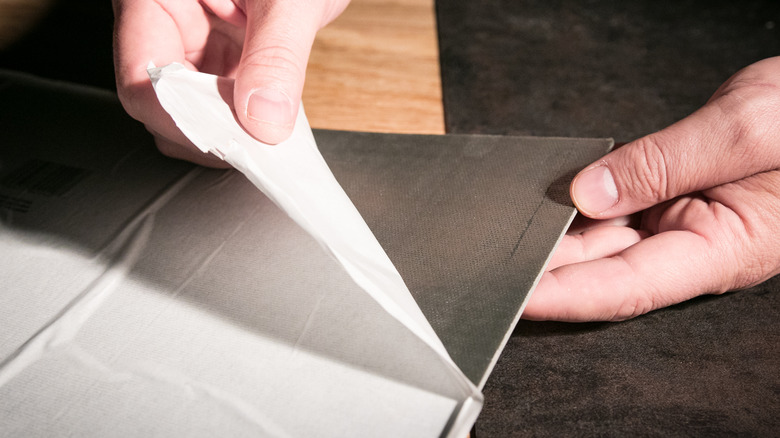Disadvantages Of Waterproof Peel And Stick Floor Tile To Consider Before Using
We may receive a commission on purchases made from links.
Waterproof peel-and-stick tiles have gained popularity as an easy hack to transform the look and feel of any room. While these tiles can work magic, it's important to consider their downsides before committing to a project. Although peel-and-stick tiles are often affordable and DIY-friendly, they can still damage your floors, and even waterproof ones may not hold up too long in damp areas.
The adhesive backing of peel-and-stick tiles makes their installation a breeze compared to traditional flooring. However, it can also create problems, as long-term use may cause permanent damage to the texture, color, and grout of your actual floor. And while you can quickly change your floor with peel-and-stick tiles by yourself, their ease is sometimes overblown. To avoid errors, you should follow the manufacturer's instructions, properly prepare your floors, and take your time with installation. If you're working in a high-traffic area, you may also need to add an extra step, like priming your floors with a sealant first.
That gets into another common issue with peel-and-stick tiles. Although some can last between 5 to 25 years, depending on their quality and installation process, the adhesive backing will eventually wear out. This can be sped up in busy areas, and tiles may shift or even curl. If you're looking to transform a space like your living room or for something that will last decades, it may be best to look at other options. You also want to take caution when placing them in damp areas like the bathroom, even if they're described as waterproof. Letting liquid pool on top of tiles can still mess with them.
How to mitigate peel and stick floor tile issues
Adding an extra step to your installation process can bypass some of the peel-and-stick tiles' cons and make this famously renter-friendly hack even better. Rather than putting these tiles straight on the floor, many people have started adding a protective layer. Contact paper and painter's tape are some popular options, but they can leave behind a sticky mess upon removal. Instead, look into something like vinyl tape, which can be placed on your original floor in strips before applying your new tiles. This extra layer makes clean-up and removal much simpler because nothing is getting on your actual floor.
If you already completed your installation without a protective layer, there's still an easy way to remove peel-and-stick tiles. Start out by using heat from a heat gun or hairdryer on a low setting to melt the adhesive backing. Any leftover residue can then be removed by going over those spots with heat again and a paint scraper or using a product like Goo Gone. Ultimately, every renovation comes with its own drawbacks, but being aware of cons beforehand allows you to prepare ways to mitigate them.
